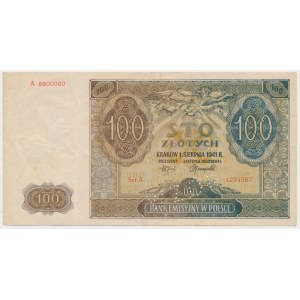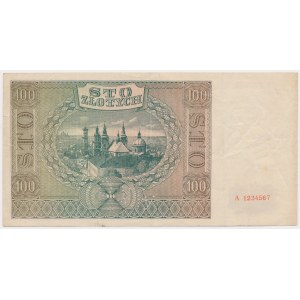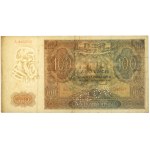Through literature published in the early part of this century, a patch was "pinned" to occupation banknotes that they had no designs at all. This information has long been "pokated", nevertheless, over the years, unquestionably correct occupation banknote designs of various kinds have appeared. Their originality was not objectionable and they are now mostly included in the catalog of Cz. Miłczek.
However, one of the patterns that did not live to see "approval" in Cz. Miłczak's catalog still remains the 100 zloty 1941 with consecutive numbering - a cash pattern, such as this one. The author continues to classify this banknote as a "forgery made on waste paper," and this is how it is described in the latest edition of his 2022 catalog. A completely different position is presented by Jerzy Koziczynski, who classifies this pattern in the Lucow Collection catalog as an original and rare value of the era, and estimates its rarity at R7.
Situational analysis
The occupation banknotes had two major issues of their own.
The first, dated March 1, 1940, in which denominations of 1, 2, 5, 10, 20, 50, 100 and 500 zlotys were issued, and the second, which can be called supplementary, dated August 1, 1941. The second issue supplemented the circulation with probably the most needed denominations in it, which were missing from the first, i.e. 1, 2, 5, 50 and 100 zlotys were issued.
The 1, 2 and 5 zlotys were reproduced in exactly the same graphic design as in the 1940 issue, but the series sequence was not continued any further, only the series, which for these denominations in the 1940 issue were one-letter, were replaced in the 1941 issue by two-letter series, starting with AA.
The 50 zloty 1941 in the general layout of the printed graphics also remained the same, only the image of the grove from the margin disappeared as printed, and "entered" the watermark. Since visually the banknote changed a bit, the series designation on it was reproduced again as it was for the 1940 issue, i.e. one-letter starting with A.
The case was completely different with the 100 zloty denomination. Here the banknote was clearly modernized. It was decided to change its format (it was reduced in size), as well as to use more advanced "shaded" printing, moving smoothly from brown on the left to green-blue on the right.
These changes were probably dictated by the detection of a large-scale counterfeit of the ZWZ Series B 100 zloty 1940 (described here). The counterfeit B-series was probably sought to be withdrawn from circulation altogether (hence the B-series originals are now rare) and a modernization of this banknote was introduced.
It seems logical that after such a modernization, specimens would be needed to be distributed around the cash registers so that cashiers would become familiar with the image of the new banknote. By the same token, it is also reasonable for them to become familiar with the typeface of its numbering device.
The preparation of a cash register pattern with consecutive numbering A 1234567 8900000 is therefore most understandable in such a situation and appropriate for this purpose. Exactly such a pattern as the one offered in this auction.
Argumentation
- This pattern is negated in the current catalog and referred to as a "forgery on scrap paper", but at the same time it is very rare, too rare for a forgery! We, in more than 20 years of dealing with banknotes, have encountered about 5 pieces of such a bill.
- Czeslaw Miłczak states that it is "made on waste paper". Waste paper (left over blanks from the printing plant) are certainly not consecutively numbered. Therefore, pieces without a number would be suitable for fabrication, which only had to be numbered. In our opinion, based on years of experience working with numismatic coins as well as their forgeries, it is practically impossible that numbering made in the later period looks exactly the same on a banknote as on circulating originals from the era. We have now analyzed this thoroughly using the computer layering method. We superimposed the numbering pieces from the original circulating pieces onto the numbering piece from this one. They overlap fully. Ideally, when superimposed, both the "Ser.A" marking and the individual digits from the numerator coincide. They all match, it's the same numerator.
- In addition to the numerator typeface alignment, the technique also agrees. Viewing under strong magnification, the numerator from the pattern in question, as well as from the originals, shows the same features and the same color. What's more, under magnification it looks like it was most likely scored on the subprint layer, and only after it was scored was the outer layer of the main print, the blue-green grid dashes, printed. Such a marking technique would also be confirmed by known half-finished pieces, e.g. 50 zloty 1936 Dabrowski, where there are unfinished pieces only with a numbering device on the subprint, but without the main layer of the example in the archive, and already completed pieces, where the main print is on the numbered subprint
- The absence of any traces of hand-cutting from the sheet also speaks against scrap paper. The edges of the present piece are cut properly, by machine, and the dimension perfectly matches that of typical circulation pieces.
- Another argument is that the 100 zloty 1941 waste paper is not at all common. As common today can be considered scrap paper of 20 zloty 1940 and possibly 1 zloty 1941. Yes, it may have been different in the past and scrap paper of 100 zloty may have been common, but if so, then all the more so was scrap paper of 20 zloty and 1 zloty also common. So why, when making such a forgery, was one not tempted to make a denomination set of designs, rather than just the 100 zloty itself?
- We have encountered arguments that this could be a forgery, as the numerator is "unstable" and "floats", but such a feature is also visible on typical, proper pieces from circulation, such as here.
Based on the above argument, we find a number of arguments that confirm the originality of this design, and we do not find any that negate it.
What's more, its creation seems perfectly legitimate, in a situation where the appearance of circulating cash was being changed, so it was necessary to distribute the cash pattern to cash registers.
In our opinion, it is an original and entirely period-made banknote.
PERFORMANCE
Doubts may be raised about the punched perforation of the MODEL, which may be from a later period. On this issue, we do not have a clear position at the moment.
Analogies can be found in the fact that the zero acceptance patterns of 1940 had a punched perforation DRUCKPROBE (the decision makers and approvers were undoubtedly Germans, so the German inscription DRUCKPROBE is as legitimate as possible). GG occupation banknotes, however, are Polish-language, i.e., directed for use in large part by the Polish population, and perhaps also by Polish cashiers. In such a situation, the Polish-language perforation MODEL also seems legitimate. However, a different type of perforator is used, with smaller holes spaced at greater intervals than on DRUCKPROBE. Here, however, this perforation does not look consistent with the one used by the printer when preparing the acceptance patterns. Perhaps it was made later, though still in the era, but by a different authority (no longer the printer) in the coinage of the distribution of the patterns, their distribution to the cash registers. It seems reasonable to mark specimen pieces in this way and to avoid putting them into circulation at face value, nevertheless this form of bag marking seems to be not very legible, too discreet, especially since even specimen pieces of withdrawn banknotes from the Second Republic period in specimens were crossed out in black so that there would be no doubt that they were specimen pieces.
HIPOTHESIS
In light of the above argument, the specimen 100 zloty 1941 with the numbering Ser.A 1234567 / A 8900000 was made in the correct printing house and in the era. The technique of its manufacture does not raise our objections. Nevertheless, for a cash pattern, it is too rare, especially since the cash registers must have been quite numerous, and as a result of the war effort, the GG currency lost purchasing power quite quickly and a great deal of it was left in the form of uncovered papers. If these patterns had been distributed around the cash registers, there should also be more of them now, and not just individual pieces appearing once every few years.
At the same time, for a checkout pattern here, there is a lack of clear external design markings. Deletions, "no value" notations, etc.
Our hypothesis: Perhaps these patterns were ordered and prepared with the idea of being distributed around the cash registers, but this idea was never realized?
A print with the appropriate numbering for such a purpose was ordered, but the implementation of their distribution was withdrawn. As a result, invalidation overprints were no longer made, and only pieces from the archives were preserved as rare, analogous to the acceptance of zero patterns. This would also reconcile the two current positions on their issue. The one represented by Cz. Miłczak, that there were no such patterns and they are pieces from scrap paper (in a way, unused resources are scrap paper), with the one presented by Jerzy Koziczynski, which we too confirm on the basis of analysis of surviving pieces, that these patterns are undoubtedly original pieces prepared fully in the era and in the proper printing house.
A kind of argument in favor of the above hypothesis is also the fact that the present piece of 100 zloty 1941 Ser.A 1234567 8900000 came to us from the non-collector's market together with a standard acceptance pattern of 100 zloty 1940 Ser.A 0000000 DRUCKPROBE (issued under an adjacent number).
The person who brought them to us also provided a history of their ownership. As a teenager, he was generally interested in old money and collected what he found in household nooks and crannies, got from his family, etc. His dad, who was working in Krakow at the time, told about his son's interest at work and one of his colleagues brought him a bundle of old banknotes for his son. Such as you mention it was a thick roll of rolled up banknotes. These were banknotes of the end of the IIRP, mainly 100 zlotys 1932/34 and occupation banknotes (incidentally, printed just in Cracow). In this file were just these two designs (100 zloty 1940 with zero numbering and 100 zloty 1941 with consecutive numbering). This was around the mid-1980s, he then distributed the received banknotes in plastic shirts, in a folder and so they have been lying around until now.
SUMMARY
Above we have presented our extensive analysis of this currency, which we hope will help you form your own opinion about it.
It is undoubtedly a very rare and intriguing in its genesis value.
The presentation is very good. A natural and uncorrected banknote, lying in a clasper with a presentation close to issue condition. Technically 3+ condition with two tears in the margins, but not only due to wear, which is more accidental and due to inattention.












